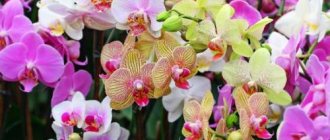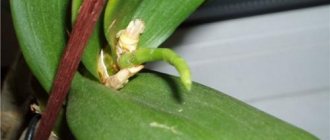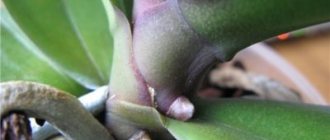Those who have been breeding orchids for a long time know that it is not immediately possible to get on the same page with this plant. First, you learn to water and replant it correctly, then, with bated breath, you wait for the young leaves to appear. And when these stages are successfully completed, the most important one comes.
This stage is caring for the orchid at the stage of releasing a new arrow, because the previous ones have already served their purpose and have dried out. And then a new peduncle “hatched” between the leaves, seemed to be actively striving upward and suddenly... abruptly stopped growing. Something clearly went wrong. But how to speed up the flowering of an orchid?
The orchid does not grow or bloom, what should I do to make it bloom? When development stopped
If the orchid has stopped blooming, does not form flower arrows and does not produce leaves, you need to analyze the conditions in which the plant is kept. Sometimes it is enough to change watering, add lighting or bring the temperature back to normal and the problem of lack of flowering is quickly solved.
Substrate
In order for an orchid to bloom, it is important to grow it only on suitable soil. Regular soil is not suitable for this flower. It absorbs a lot of liquid and contains high concentrations of minerals. Also, a substrate based on sphagnum moss is not suitable for cultivating orchids. It has a high moisture capacity and can cause rotting of the root system.
Important!
If the soil is not selected correctly, a putrefactive process in the roots will necessarily develop. A diseased epiphyte does not bloom.
Sometimes the reason that flowering does not begin is the unbalanced mineral composition of the soil. With a high nitrogen content, the root system and greenery grow. Increased phosphorus content is important to encourage flowering. To feed an orchid, do not use conventional mineral complexes. This plant needs special, liquid forms, which are applied before the peduncle begins to grow. When the peduncle and buds form, you need to stop feeding the orchid.
How to distinguish the root from the peduncle of an orchid: care recommendations An orchid is a fascinating and unusual flower. Phalaenopsis grows in many homes and is quite popular. For…
Lighting
Most varieties of orchid plants bloom only with prolonged light. They need a lot of indirect light to bloom. Direct ultraviolet rays are unacceptable, as they cause burns on the leaf plates. Daylight hours for epiphytes last 12 hours. Therefore, in autumn and winter it is increased artificially by illuminating the flowers with phytolamps.
Temperature and humidity
The tropical forest in the homeland of epiphytes is humid and warm. Therefore, when cultivating an orchid in an apartment, you need to create the same conditions for it to bloom. In summer it is kept at temperatures from +15 to +30 degrees. In winter, the suitable temperature range is from +20 to +23 degrees. To make a phalaenopsis orchid bloom, the fluctuation between day and night air temperatures must be 5 degrees.
Proper watering
Beginning gardeners often get carried away and water the orchid too much. Therefore, the flower does not experience a physiological need to bloom. Under natural conditions, abundant irrigation of the flower occurs during the rainy season, when the orchid begins to grow roots and leaves. Excess moisture often provokes putrefactive processes, which can also cause a lack of buds. To eliminate rotting, the affected parts of the roots are cut off, these places are treated with activated carbon and the orchid is transplanted into a fresh substrate.
How to activate plant development?
After you have found out the reason for stopping the growth of new leaves, you need to take active action and try to correct the situation in 1 month.
Shock change of scene method
An effective way to bring orchids out of long-term hibernation, according to many experienced gardeners, is a “shock” change of environment .
In order for an orchid to produce new leaves, it needs to be put in a stressful situation.
The method involves a sharp change in the conditions of the flower and this usually affects:
- Temperature;
- And lighting mode.
Using this method, you can bring the orchid out of hibernation and return it to normal life.
Changing the content temperature
The “shock” system, associated with a sharp change in temperature, involves placing the plant in a room with a constant temperature of 15 degrees above zero for 45-60 days.
Thus, a short tropical winter will be simulated , during which this is usually the temperature in the orchid’s homeland. After 1.5 - 2 months of keeping the flower in relative cold conditions, it is transferred to a room with a temperature of 22-25 degrees Celsius. It seems to the plant that spring has come again, and it resumes its rapid development.
Changing the lighting mode
There is also a “shock” technique associated with a sharp change in lighting intensity . It is similar to the previous technique, only instead of temperature the lighting changes sharply.
To do this, you need to place the orchid pot in the shade for 45 days, moving it, for example, from the south window to the north side, placing it in the corner of the room .
After 1.5 months, the pot is immediately moved to a room with intense sunlight. Such a large luminous flux will, as it were, tell the plant that spring has come - the time when it is necessary to hurry to grow and develop.
Application of fertilizers
Orchids can be fed with the same mineral fertilizers as other crops. It is important to understand that at different periods they require fertilizing with fertilizers containing different nutritional elements.
To increase the green mass of orchids, including the growth of leaves, they need to be fed with nitrogen fertilizers . Nitrogen is the basis of all living things, and if there is a deficiency in the nutrient substrate, the plant will not be able to develop normally.
Important! During the flowering period, orchids require more phosphorus, and during the budding phase they will need not only phosphorus supplements, but also potassium supplements.
The orchid grows, but does not bloom, what to do to make it bloom. Analysis of orchid keeping conditions
When buying a flower, you need to ask a specialist for an explanation of what variety it is and the characteristics of its cultivation. Phalaenopsis orchid, the most unpretentious variety that tolerates light shading. But there are orchids for which a south window is suitable, and even summer heat is tolerated well by them. An orchid does not bloom if the conditions of its maintenance are violated.
You should always place a saucer of boiled water next to the orchid. Place a clove of garlic in the substrate.
If the flower was purchased in a store, and it was already blooming, and the arrow turned yellow, then the rest period can last up to a year. If the plant is grown from children, then it will take more than two years to wait for the first flowering. By this time, the root system will gain strength and the orchid will produce 5-6 leaves. Early flowering will weaken the beauty.
Why doesn’t an orchid bloom at home after transplantation? When should we expect the first arrow? The transplanted plant initially builds up its root mass within six months. Afterwards, aerial roots develop and leaves grow. Flower buds are formed in the axils. The initial period of plant development in favorable conditions contributes to the laying of a larger number of flower stalks.
Let us remind you how to properly maintain an orchid:
- The roots are well developed, green, some of them are located on the walls of the transparent pot, some are at the top, absorbing moisture from the air.
- The substrate does not contain fresh bark, sawdust or manure.
- It is better to keep the lighting diffused.
- The difference in day and night temperatures when planting flower stalks should be at least 5 degrees.
- Fertilizing with liquid fertilizers depleted in nitrogen once every 10 days before the arrow shoots.
The conditions for laying flower buds are listed, but biological requirements for the maintenance of orchids must be observed.
What to do if the orchid does not bloom or develop well? It will be necessary to provoke the release of the arrow. The aerial root and the arrow look the same at first. But the tip of the arrow is rounded, and at the root it is sharp, as in the photo.
Control measures
Phalaenopsis is an exotic species, so a couple of limp and soft leaves is not a problem. There is no need to remove them: even in this state, they give nutrients to the plant. We have to wait until they disappear on their own.
If most of it has withered, this is already a clear cause for concern. The flower needs to be helped to recover, and the sooner the better:
- Make sure that the orchid's limp leaves are not due to overheating or hypothermia. Remember when the last watering was done. Measure the temperature in the room to see if it is too high. The sun's rays should not fall on the flower. If this is the case, move the pot to another place, move it deeper into the room. This is done so that the temperature of the roots gradually reaches the required level.
- Rock the socket. This will ensure that the orchid's root system is normal. If the flower swings freely, the roots have dried out or rotted. In this case, you will need to remove all diseased parts of the root system, and treat healthy parts with an antiseptic. It should not contain alcohol.
- If the flowers of a blooming orchid have become limp due to overheating, spray the plant or wipe them with a damp cloth. This will help revive wilted leaves. Also keep an eye on the room temperature. If the flowers have wilted due to overheating, add a little special drug to the watering water to reduce the stress level of the flower.
- If the orchid leaves become limp due to insufficient watering, the plant should be watered with a special solution. After drying, water the flower with water with added succinic acid. Watering is done by immersion in water; the temperature of the liquid should be about 40°C. The duration of the procedure is about an hour.
- If infected with parasites, collect ticks, and then treat the plant with a special anti-pest solution.
Phalaenopsis orchid does not bloom, what to do to make it bloom. How and when does the phalaenopsis orchid bloom?
So, first we need to understand one botanical feature of the development of our tropical guest. When does the phalaenopsis orchid bloom - the answer to this question hides the accompanying answers to all possible questions of inexperienced gardeners regarding why the orchid does not bloom for a long time. So, the phalaenopsis orchid blooms for the first time no earlier than 2 years from the moment of its planting. Therefore, if a flower is planted with the help of a child, then you should wait for at least 6 full-fledged leaves to form and then sound the alarm.
Immediately after planting, the plant begins to build up its root mass. Depending on planting conditions, this may take at least 6 months. And only after this the development of aerial roots and leaf mass begins. This is a very important time, since flower buds of future flower stalks are laid in the axils of new leaves. Therefore, as soon as the tops of new leaves begin to appear, you should begin actively feeding with mineral complexes. But be careful. It is best to exclude nitrogen from fertilizers or buy formulations where it is contained in the lowest ratio. Phosphorus, potassium and magnesium are needed to lay future flower stalks.
Another important point regarding the question of when orchids bloom. This tropical plant has no concept of changing seasons. In principle, it does not know that here, in our latitudes, there is winter and the time has come to shed the leaves and stop flowering. The phalaenopsis orchid is not particularly sensitive to the length of daylight hours, since under natural conditions it grows under the cover of dense foliage of the tropical forest. Therefore, the phalaenopsis orchid can bloom without interruption for up to 10 - 11 months. The time when it throws out a peduncle depends entirely on the skill and experience of the grower.
The light from your window...
There is an opinion that tropical plants are very supportive of shade.
Allegedly, they live calmly and develop well under the dense canopy of trees. This means that at home, a semi-dark place in the back of the room is quite suitable for them. Thanks to such conditions, more than one beautiful woman was killed. And you don’t even have to think about flowering. Where to place an orchid so that it blooms? On the windowsill, of course! It is there that she will have enough lighting for normal growth and development. After all, in natural conditions, tropics grow on the bark of trees in order to rise higher towards the sun.
Therefore, the room should be light. Don't have such a window sill? Immediately purchase a special lamp for additional illumination. Otherwise you will never see flowers.
Owners of southern and western window sills have a different problem. The harsh Russian summer often surprises. And direct sunlight burns the leaf plates great. But you shouldn’t drag the orchid pot to another window. It is enough to make a scattering screen. It can be white paper, thick tulle or even a piece of light fabric. There will be plenty of light, but it will not burn the tender leaves. Flowering will occur fairly quickly and will last a long time.
The orchid grows leaves and does not bloom.
belong to plants that are valued for their magnificent appearance.
That's why they buy them. It’s a shame when plants, having shed their withered petals, are in no hurry to delight again with a riot of colors, only releasing new leaves month after month. Experienced flower growers know that this is not a whim of an overseas guest, but a normal reaction to the conditions of detention! If the owner does not correct them, then he may never wait for new flower stalks to appear. There are two ways:
- . It consists of artificially creating ideal conditions for the rapid ripening of flower stalks using supplementary lighting and humidity changes, and applying a large complex of fertilizers. Used in the industrial cultivation of orchids for retail chains. Suitable for experienced flower growers who are engaged in forcing buds by a certain date;
- Traditional way. Ensures natural life cycles. It does not exclude additional illumination with phytolamps, compliance with humidity and temperature regimes, and application of fertilizers, but does not accelerate the natural rhythm of plant development, but brings home maintenance closer to ideal conditions. Recommended for beginning gardeners.
Is your plant healthy?
Only a healthy plant can bloom. If they do not appear for a long time, it is necessary to check the condition of the pet, its roots and leaves. They will tell you:
- unpleasant, putrid smell from a flower pot;
- slimy, falling apart roots;
Only after healing can you expect a full growing season!
The right look
If the pet is healthy and happy with the living conditions, it looks like this:
- tightly wraps the roots around the substrate and does not wobble in the pot;
- the roots are strong, elastic, light or dark green in color;
- pseudobulbs smooth;
- the leaves are even, of the same shape and size, glossy, smooth, elastic, without plaque, brown or black spots.
With such data, we can expect the long-awaited flower stalks to appear soon.
This is what a healthy orchid looks like.
Reasons why an orchid does not bloom, but only leaves grow
If a close examination shows that the pet is generally healthy, but does not bloom and only produces foliage, then the reason must be sought in the conditions of detention that were created for it:
- Lighting. Most species require additional lighting to increase daylight hours. This provides comfort mode. If a pot with a light-loving specimen stands on the north side of the house or occupies a place in the back of the room, then it lacks light. This may be indicated by fairly elongated stems, leaves that have acquired a thick dark green color;
- Drainage. Perhaps its layer is not sufficient to protect the roots well from stagnant water and ensure respiration;
- Root color. The florist uses it to navigate when it has arrived. Healthy roots have a rich green or grayish-pearl color. Brown color is a signal of waterlogging or hypothermia;
- Watering. The correct regimen is very important. It is worth analyzing how well the irrigation schedule corresponds to the natural rhythm? Are dry periods observed? Is the plant over-watered?
How to determine the need for watering.
- Nitrogen fertilizers. It is necessary to evaluate how intensively they are used? This is an important part of agricultural technology, but it is important to remember that each period of life has its own healthy amount of microelements. Nitrogen fertilizers promote the growth of green mass, but they do not ensure the formation of flower stalks.
Important! Only a healthy plant that has an ideal atmosphere close to natural will bloom!
Measures to eliminate them
Having identified the reasons for the lack of flowers, you should begin to create a favorable atmosphere for the growing season. So, we tell you what to do if the plant produces only leaves without a peduncle:
- Selecting the right substrate. In some cases, it should be replaced with a fresh one or something more suitable for the given purpose. Ideal components - steamed, dried pine bark, coconut fiber - should ensure rapid drying and breathing of roots. Soil, as a rule, is not required. On the contrary, its presence can destroy the plant;
- Organization of proper watering. The ideal method is to immerse the flower pot in a tray of water for a few minutes. Then the pot is taken out, the water is allowed to drain, and it is put back in place. Experienced gardeners water in the usual way: from above over the ground, while making sure that water does not accumulate in the pan. Watering should be done approximately once a week. It is advisable to pre-settle the water for 24 hours;
- Additional lighting. If the exotic is located in the back of the room, on the northern windowsill, or it is planned to artificially stimulate its flowering, then daylight hours should be increased for it using special lamps;
- Choosing the optimal location. It is best to place flowers on eastern and south-eastern windows. Some species, for example, can live in the back of the room if the room is bright enough and the windows are not darkened by blinds or curtains;
- Proper feeding. Extremely important for the formation of flower stalks! To stimulate, the proportion of nitrogen decreases and the content of phosphorus and potassium increases. You can use ready-made complex preparations or add microelements separately. It is important to follow the regimen and dosage, since exceeding it will lead to the opposite result - flower disease.
Never exceed the recommended dose of fertilizer.
Stimulating flowering with stress
If the orchid is healthy, has had enough rest, and is in ideal condition, then it is called using the stress method - using a temperature drop mode or artificial drought:
- Temperature difference. The orchid is taken outside or onto a glassed-in balcony at night. Night air temperature should be at +16 C, not lower. During the day, the potty is returned to the room. The cycle continues for one to two weeks, after which flower stalks should appear;
- Drought. The intervals between irrigations are approximately doubled. It is important to remember that during this period the leaves are not sprayed or fertilized to create the effect of complete drought. The peduncle will appear in one to two months. After this, they return to normal watering mode.
Important! It is impossible to constantly use stress stimulation of flowering, as this will lead to exhaustion of the plant and, possibly, its death! A period of rest and rest is mandatory!
Useful
You will learn about preparing a substrate for an orchid yourself from this video: The following video talks about proper watering of orchids: This video is dedicated to feeding orchids: From this video you will learn how to make orchids bloom:
Conclusion
Caring for orchids requires care and discipline. The florist should immediately create an optimal atmosphere for the green pet. For this:
- when purchasing, find out what type of exotic you are purchasing;
- clarify the features of the regime;
- so that the information is not forgotten over time, you can attach a sign to the pot with the name of the orchid, symbols indicating the requirements for watering, light, and temperature.
Under ideal conditions, the orchid will certainly delight you with beautiful blooms on a regular basis.
Water, water, water all around...
Improper watering is the main reason why an orchid does not bloom and only leaves grow. Few people, when buying a beauty in a store, bother to read the care information. Tropics means damp. And every day they pour a large amount of liquid into the pot. It turns out there are 2 options for the development of events:
- The pot has good drainage, and excess liquid flows safely through the holes into the tray. At the same time, it does not have time to wet the soil. It turns out that there was no watering as such. It's good if the plant is healthy. It will be able to exist in tantalum torment for a long time. But there will be no flowering.
- Drainage holes are clogged with soil and roots. It turns out to be a swamp. This is where the unfortunate orchid will survive for the time being. Then the roots will safely rot and the plant will die.
How to water an orchid so that it blooms? Only by immersion method. It is useless to do this from above. Place the pot in a large container, pour water to the middle. They forget for 10-12 minutes. Then add liquid almost to the very top. And again they wait about 11-13 minutes. After the procedure, the container with the orchid is placed on a stand to drain excess water.
Now the plant can be returned to its usual habitat and wait for flowering. This watering procedure saturates the substrate quite well. There will be enough moisture for about 10-14 days. Then they repeat everything.
Advice. Focus on the color of the roots. A light green tint indicates sufficient fluid. Silver-white signals that it’s time to give the beauty a drink.
Oh, my box is full!
Regular feeding very actively stimulates the maturation of flower stalks. And most gardeners simply ignore this rule. They believe that the orchid has enough microelements that are in the soil. This is a great misconception.
Under natural conditions, the plant feeds on those minerals that settle on its aerial roots in the form of dust. Plus very fatty, but loose perennial humus in the cracks of the bark. Are you able to provide her with such conditions? No. So, go to the store for some fertilizer.
- The words “for orchids” on a bag or box
- Mandatory presence of phosphorus and potassium in the composition.
- Minimum nitrogen.
- Competent instructions for use with precise dosage and frequency of treatments.
- Precautionary measures and hazard class.
After purchasing, you go home and reread everything again. And you begin to slowly feed your orchid. How often to fertilize? About once every 9-10 days, but with a dose reduced by half. Because an excess of microelements is just as destructive as their deficiency.
Advice. Try using tablet forms of fertilizer. Then there will be no need to accurately measure the dose, and the orchid itself will take as much food as it now needs.
What to do with the peduncle
You can tell that the phalaenopsis has faded by looking at the condition of the tip of the peduncle. If it has dried out, turned yellow, blackened, or looks ugly in the photo, the orchid will no longer bloom. In this case, the peduncle must be removed.
When working with an orchid, it is important to remember that it has dormant buds hidden behind special scales. There can be up to 4 such buds. If you care for the flower correctly, the shoots can develop and become a peduncle or a baby.
In order for the phalaenopsis to bloom again and look beautiful in the photo, it is recommended to cut the peduncle a couple of centimeters above the buds, since old peduncles slow down the development of new ones. However, it is worth remembering that the pruning procedure is not a guarantee that the buds will definitely wake up.
What to do with the arrow so that children are formed? Provide the plant with a humid climate, a temperature of about +25 degrees. Then, with a high degree of probability, the dendrobium will have a baby.











